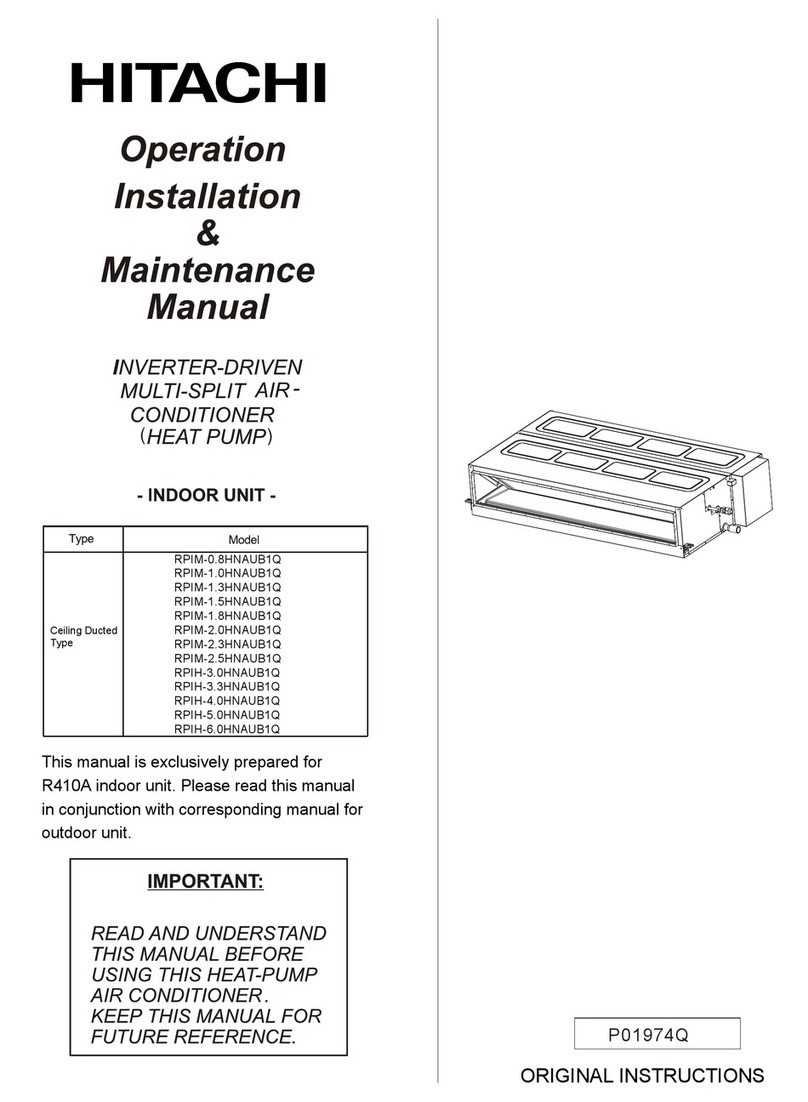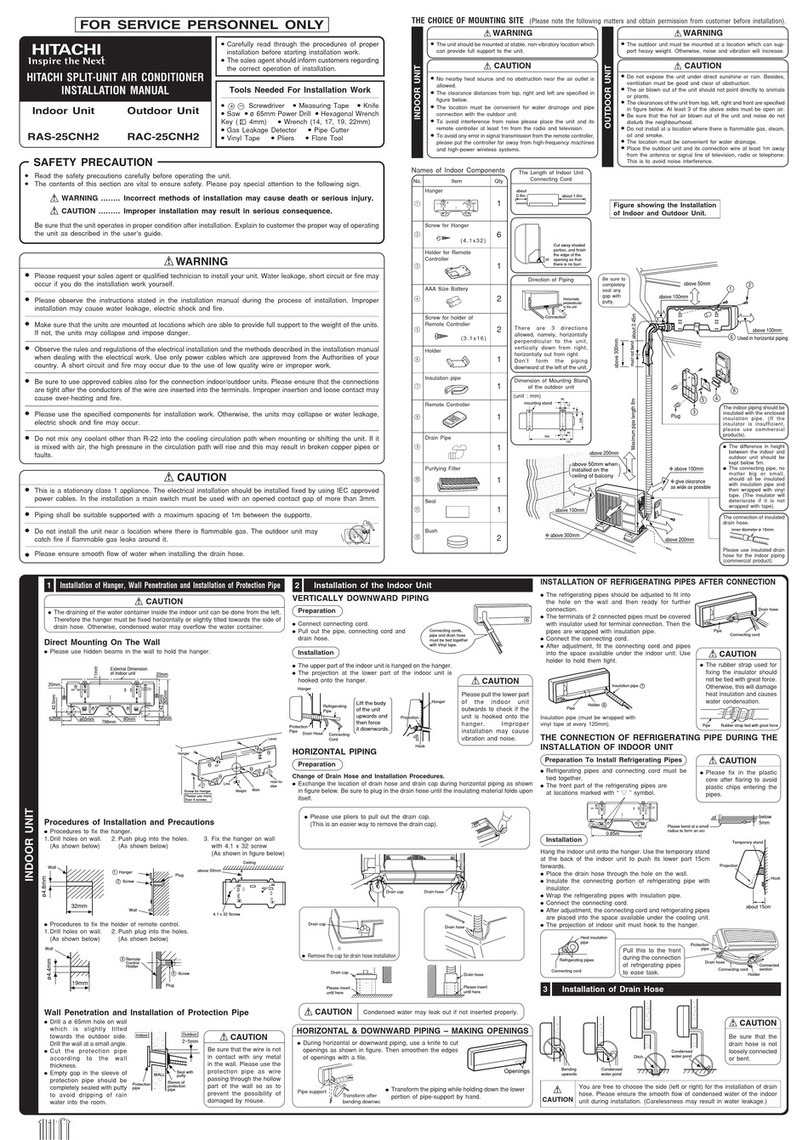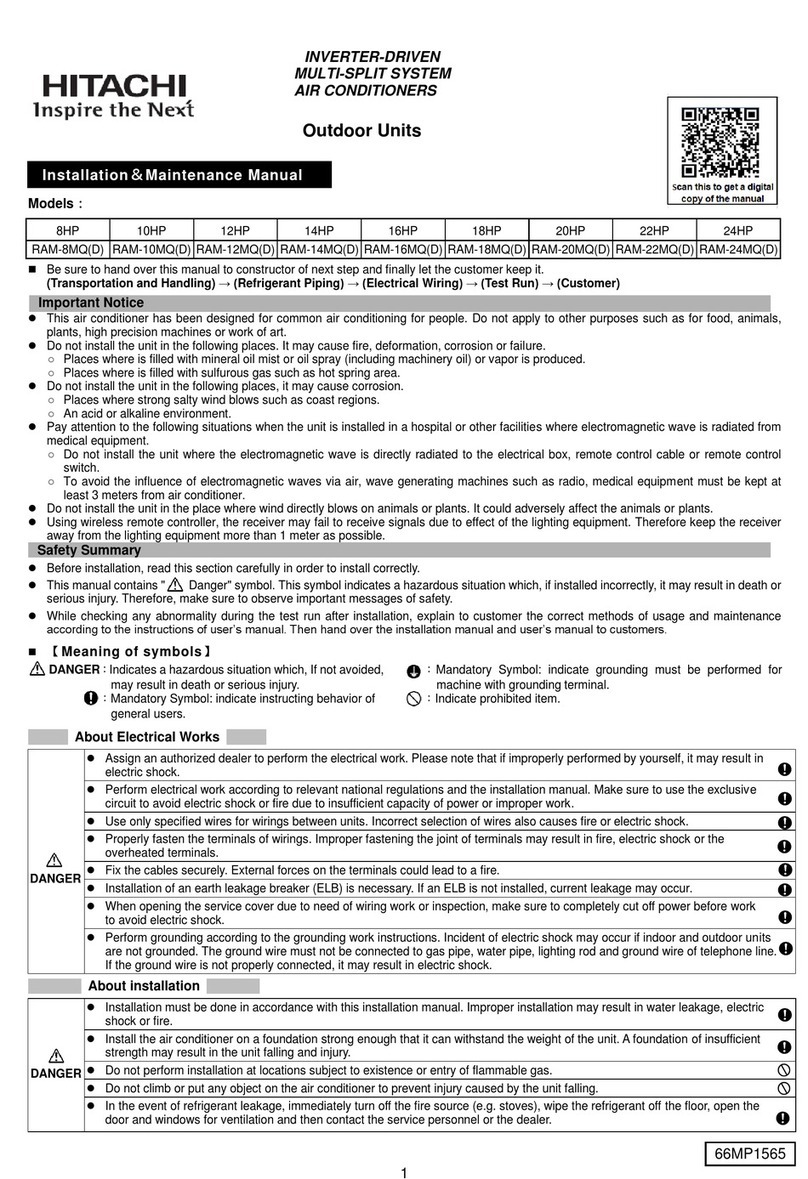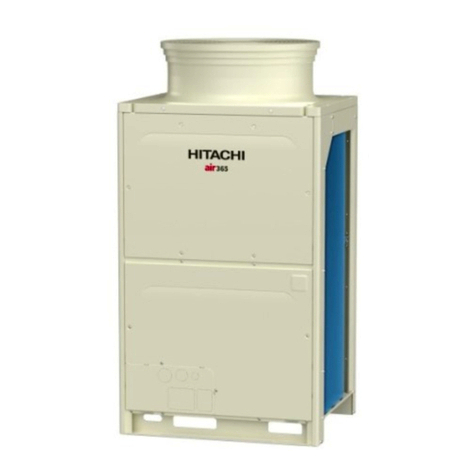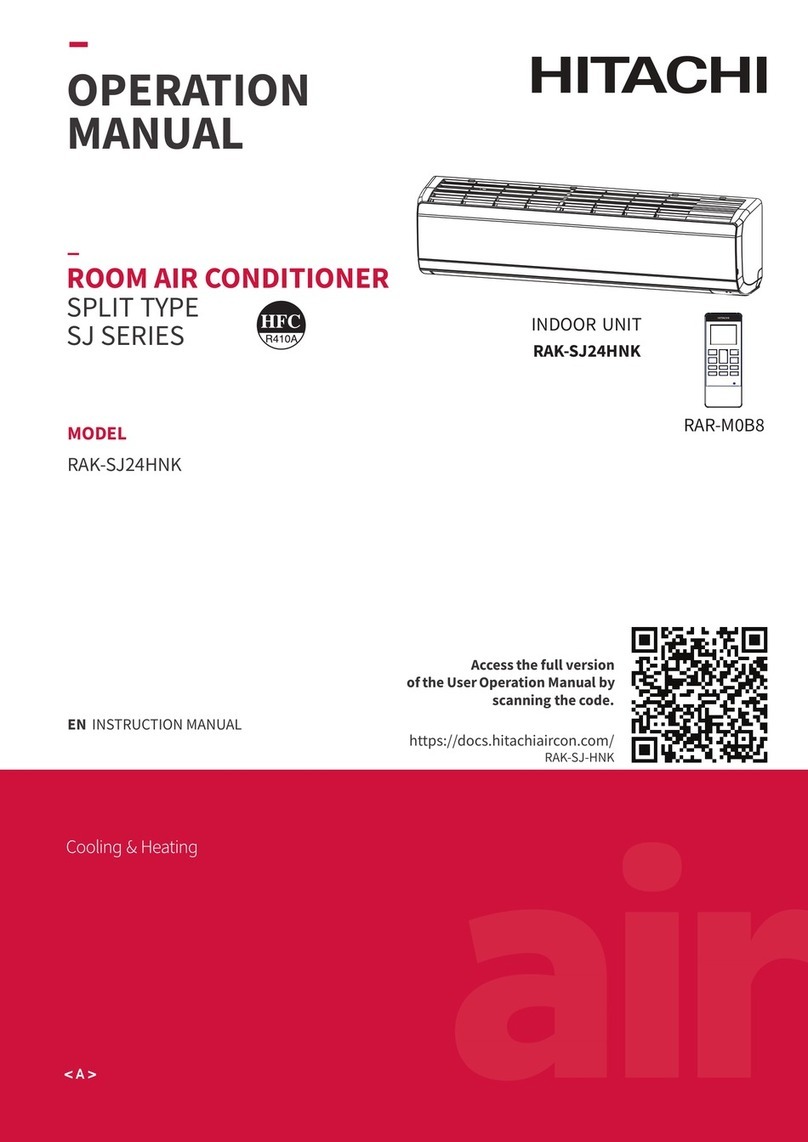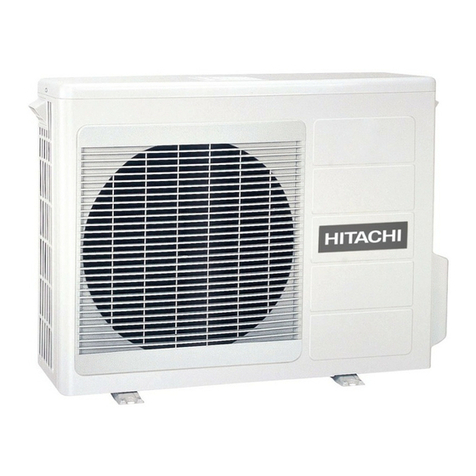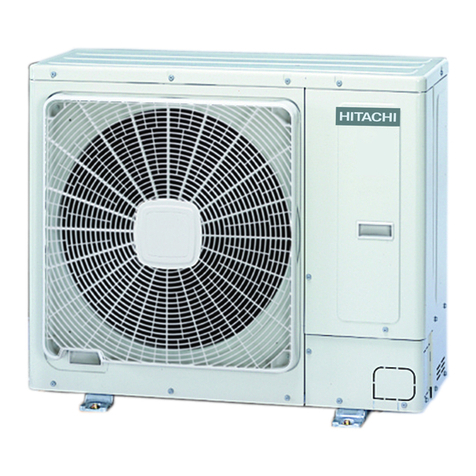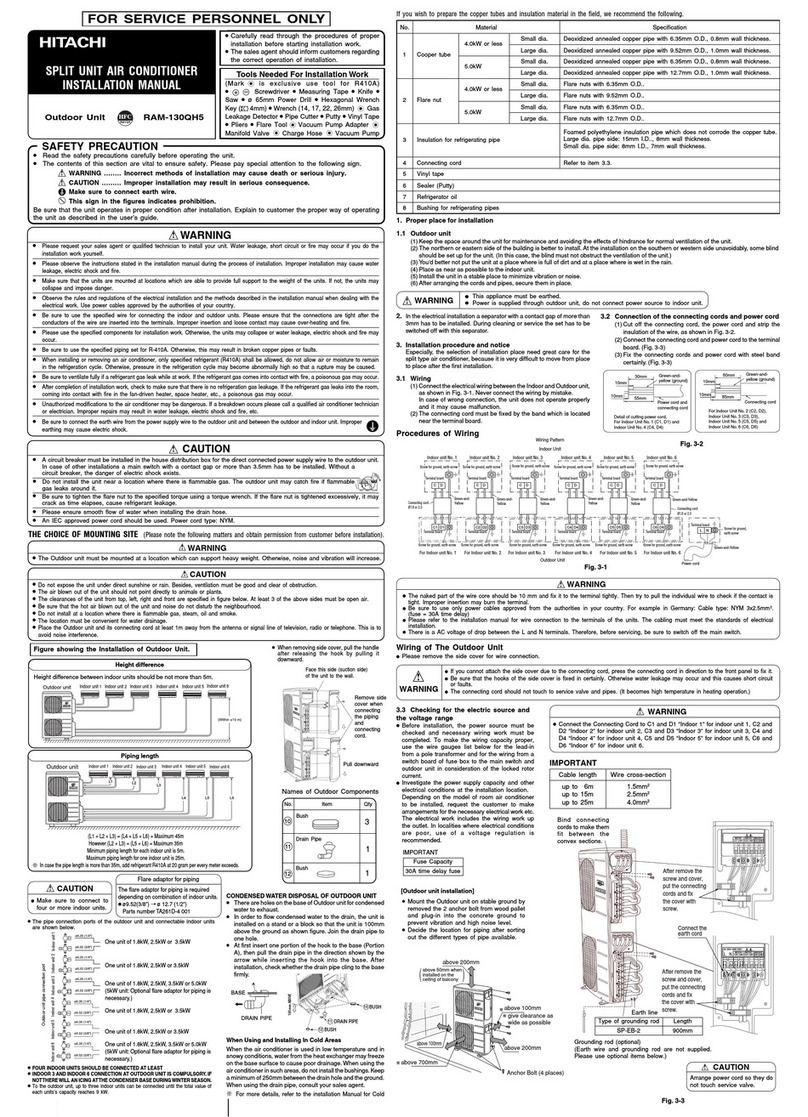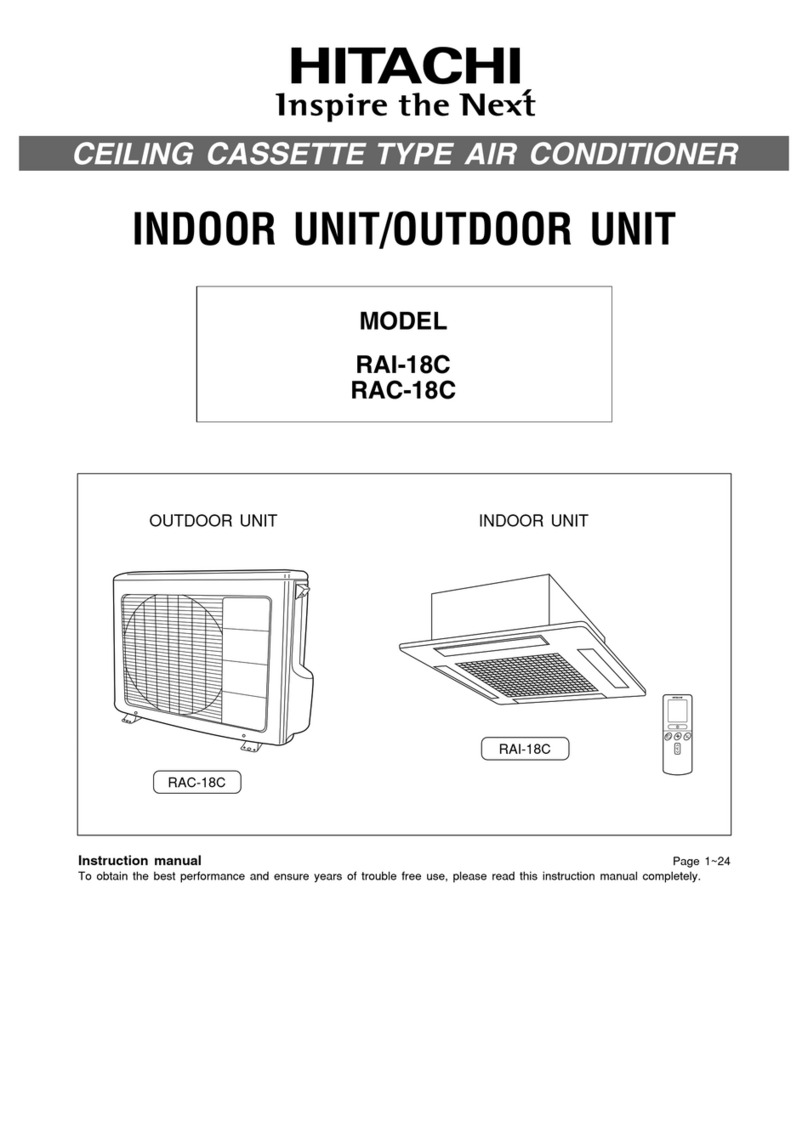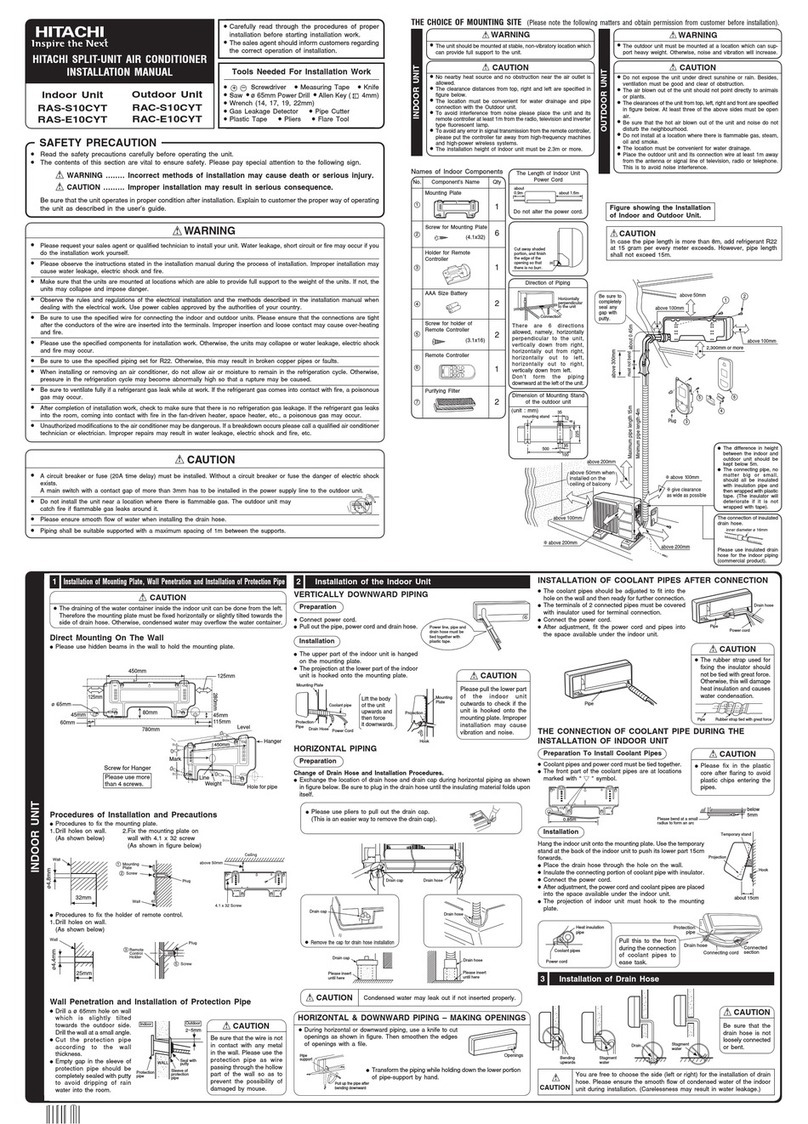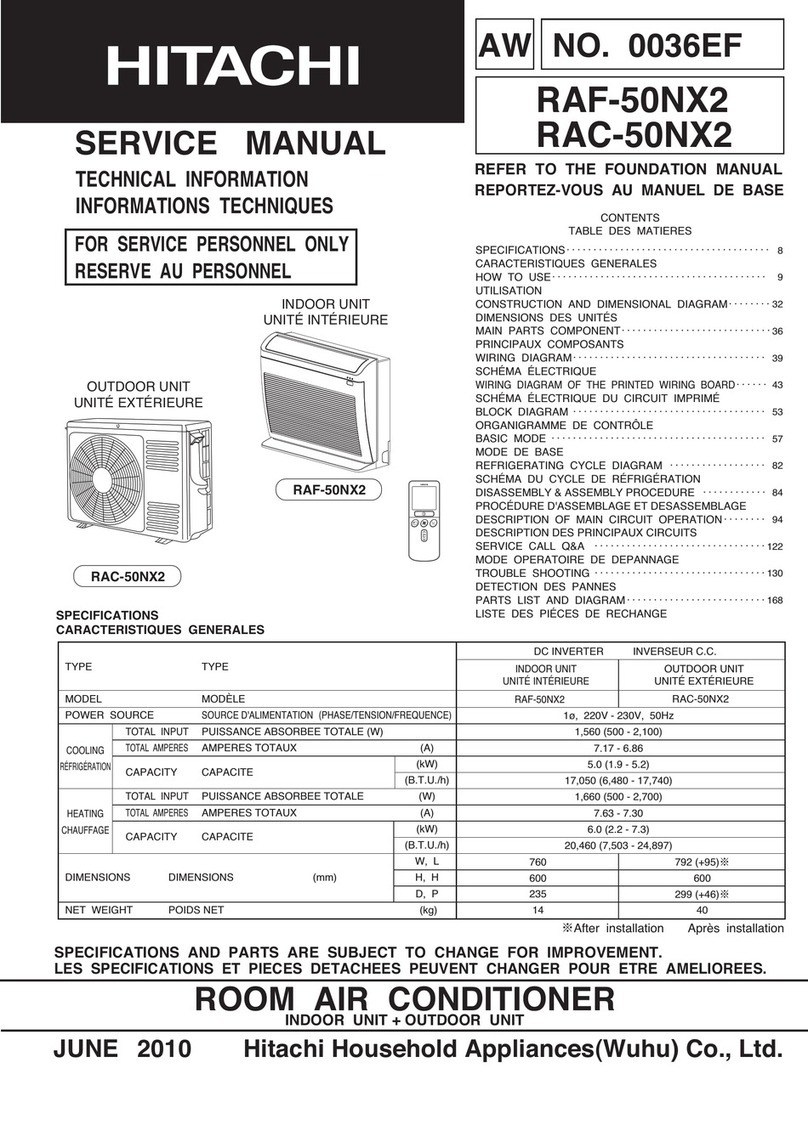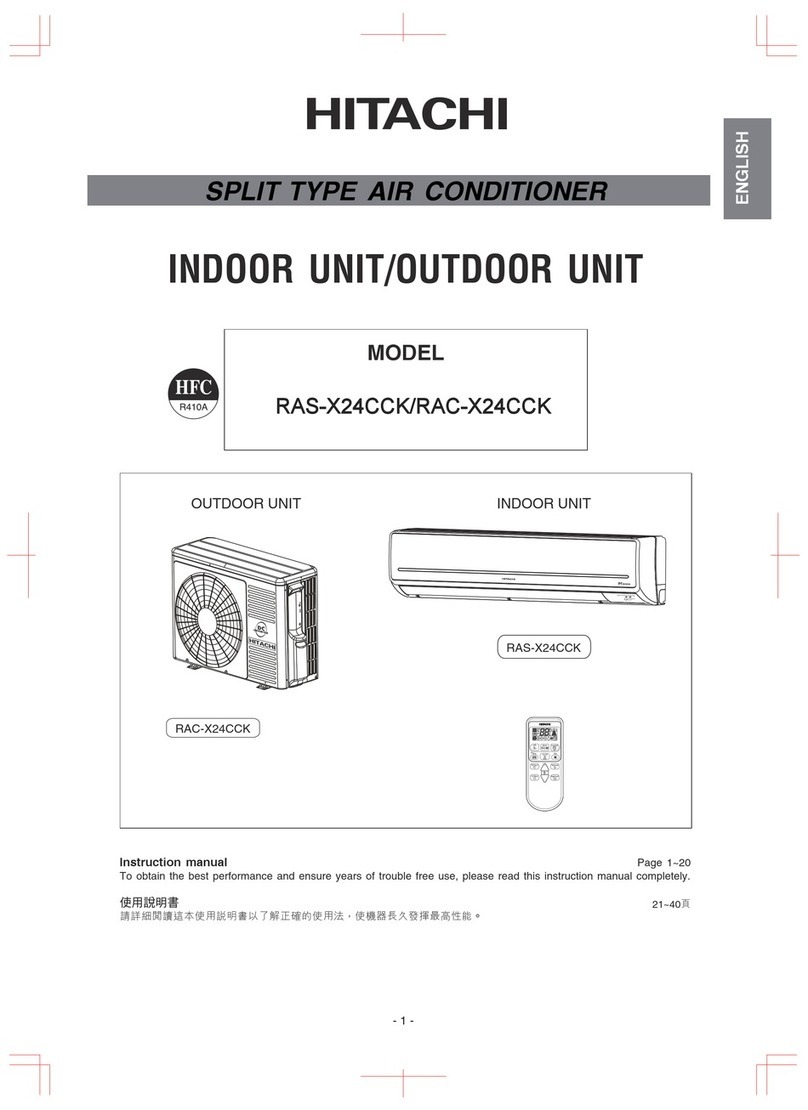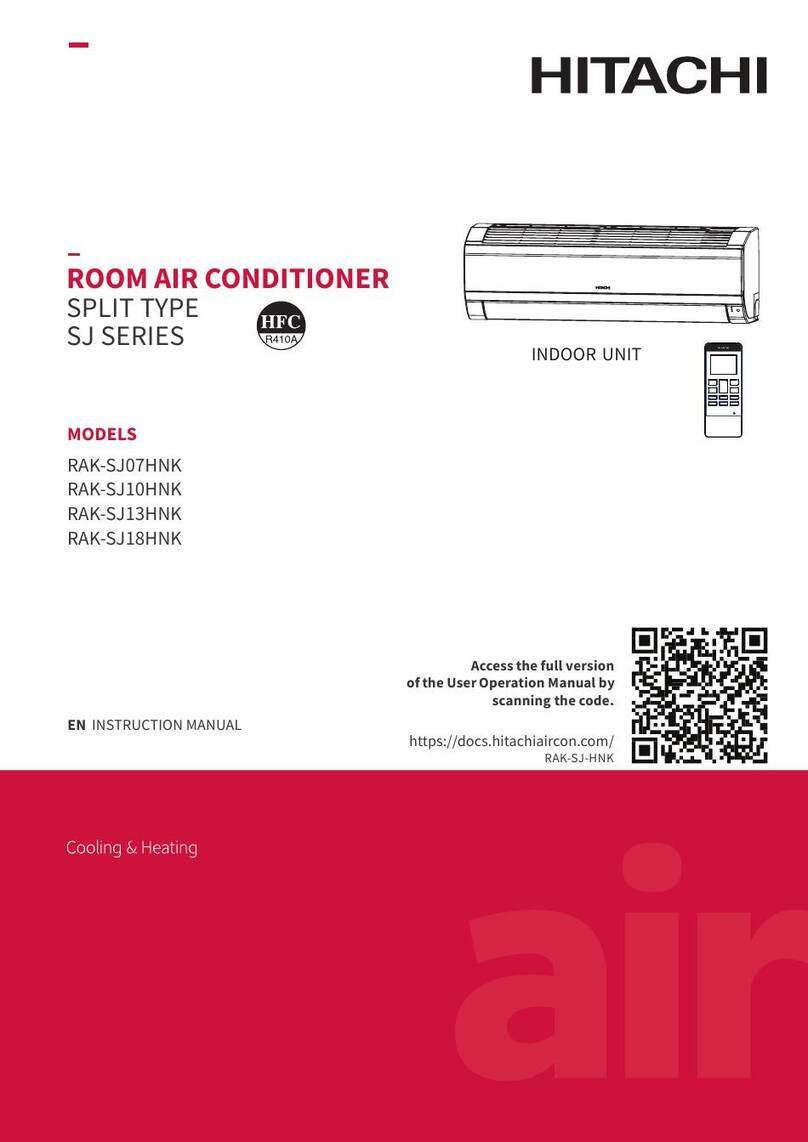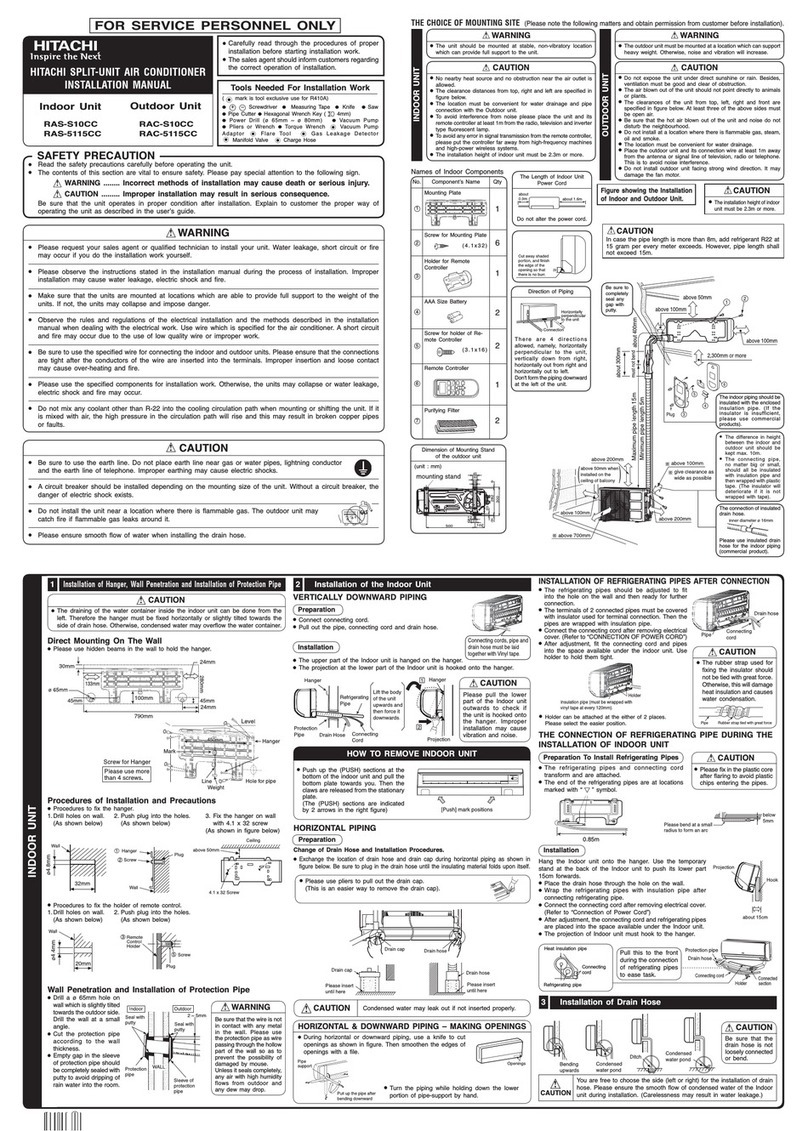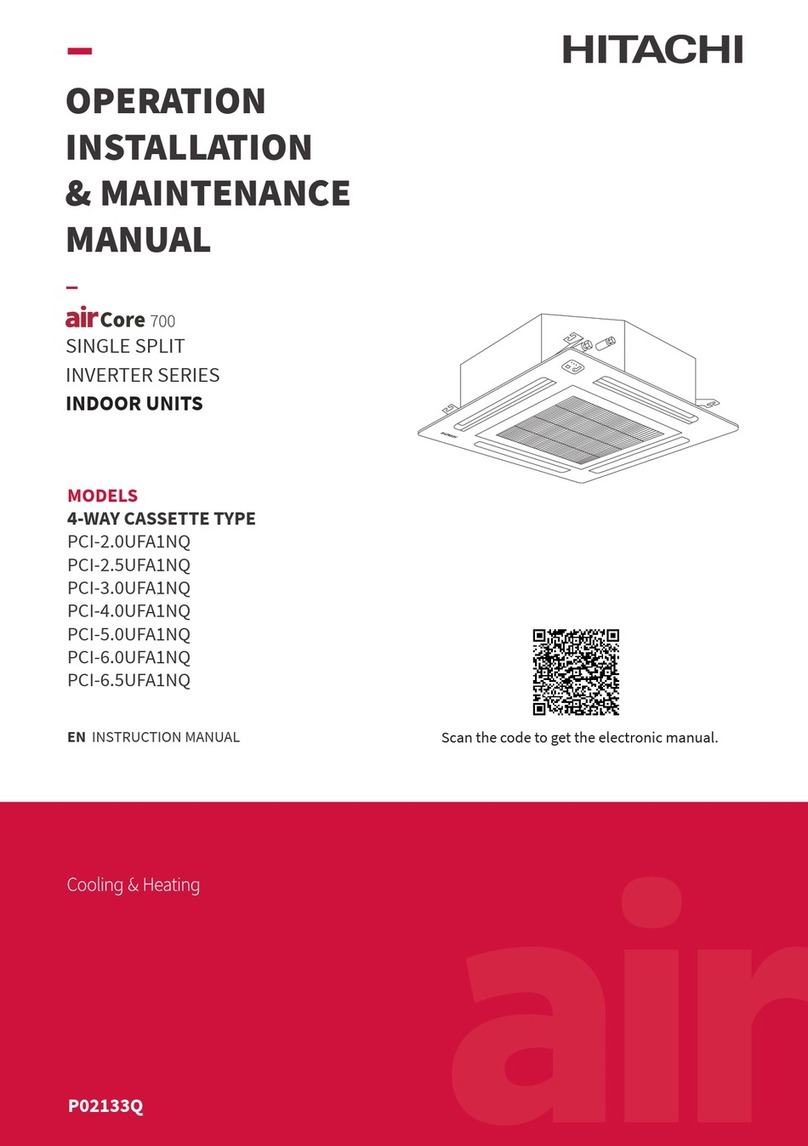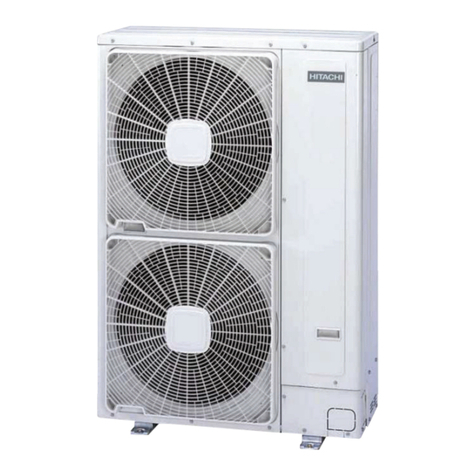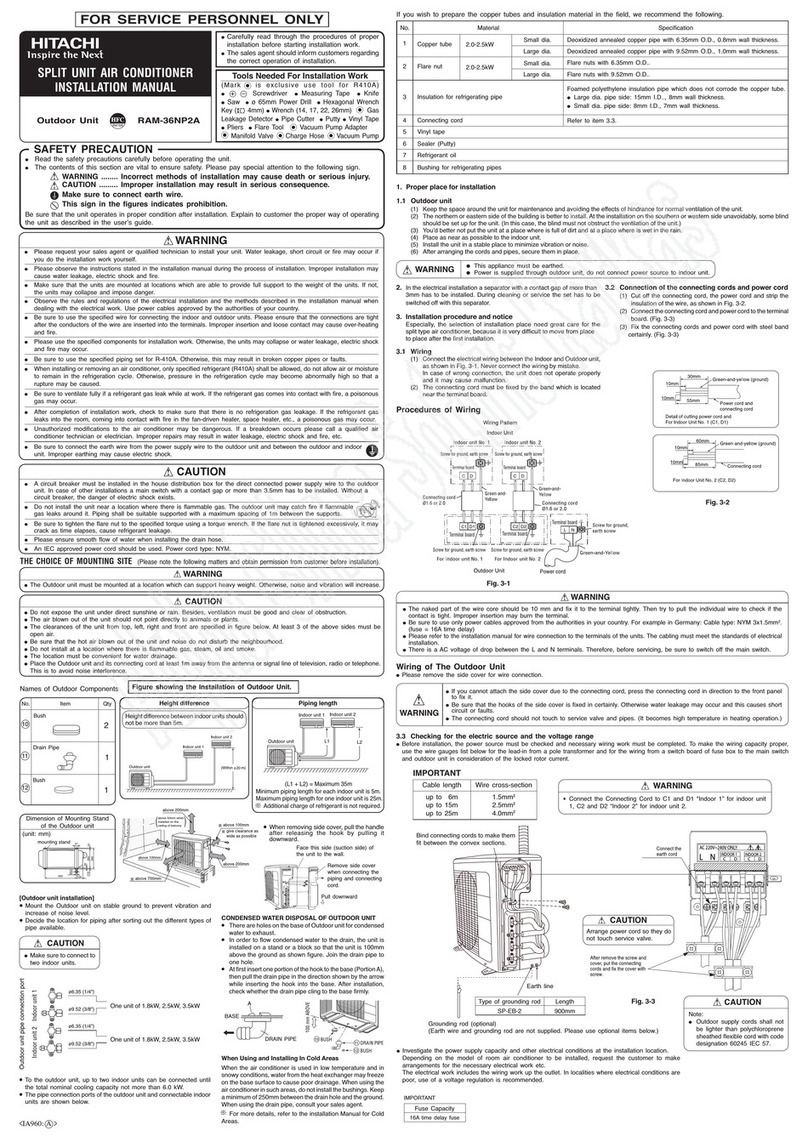
< S581 : C>
FOR SERVICE PERSONNEL ONLY
INVERTER SYSTEM MULTI TYPE
INDOOR UNIT
INSTALLATION MANUAL
MODEL RAF-25NH4
RAF-50NH4
• Carefully read through the procedures of proper installation
before starting installation work.
• The sales agent should inform customers regarding the
correct operation of installation.
• Explanation for outdoor unit is in the “How To Use”
(Instruction Manual) that packed with outdoor unit.
Tools Needed For Installation Work
(Mark is exclusive use tool for R410A) • ª· Screwdriver
• Measuring Tape • Knife • Saw • ø65mm Power
Drill • Hexagonal Wrench Key ( 4mm) • Wrench
(14,17,22,26,27mm) Gas leakage Detector • Pipe
Cutter • Putty • Vinyl Tape • Pliers • Flare Tool
Vacuum Pump Adapter Manifold Valve Charge
Hose Vacuum Pump
• Read the safety precautions carefully before operating the unit.
• The contents of this section are vital to ensure safety. Please pay special attention to the following sign.
WARNING .... Incorrect methods of installation may cause death or serious injury.
CAUTION...... Improper installation may result in serious consequence.
Make sure to connect earth line.
This sign in the figures indicates prohibition.
Be sure that the unit operates in proper condition after installation. Explain to customer the proper watt of operating the unit as
described in the user’s guide.
SAFETY PRECAUTION
WARNING
•Please request your sales agent or qualified technician to install your unit.Water leakage, short circuit or fire may occur if you do
the installation work yourself.
•Please observe the instructions stated in the installation manual during the process of installation. Improper installation may
cause water leakage, electric shock and fire.
•Make sure that the units are mounted at locations which are able to provide full support to the weight of the units. If not, the units
may collapse and impose danger.
•Observe the rules and regulations of the electrical installation and the methods described in the installation manual when dealing
with the electrical work. Use wire which are approved official in your country. A short circuit and fire may occur due to the use of
low quality wire or improper work.
•Be sure to use the specified wire for connecting the indoor and outdoor units. Please ensure that the connections are tight after
the conductors of the wire are inserted into the terminals. Improper insertion and loose contact may cause over-heating and fire.
•Please use the specified components for installation work. Otherwise, the unit may collapse or water leakage, electric shock and
fire may occur.
•When installing or transferring an air conditioner to another location, make sure that air other than the specified refrigerant
(R410A) does not enter the refrigeration cycle. If other air should enter, the pressure level of the refrigeration cycle may increase
abnormally which could result in a rupture and injury.
•Be sure to use the specified piping set for R410A. Otherwise, this may result in broken copper pipes or faults.
•When installing or removing an air conditioner, do not allow air or moisture to remain in the refrigeration cycle. Otherwise,
pressure in the refrigeration cycle may become abnormally high so that a rupture may be caused.
•Be sure to ventilate fully if a refrigerant gas leak while at work. If the refrigerant gas comes into contact with fire, a poisonous gas
may occur.
•After completion of installation work, check to make sure that there is no refrigeration gas leakage.If the refrigerant gas leaks into
the room, coming into contact with fire in the fan-driven heater, space heater, etc., a poisonous gas may occur.
•Unauthorized modifications to the air conditioner may be dangerous.If a breakdown occurs please call a qualified air conditioner
technician or electrician. Improper repairs may result in water leakage, electric shock and fire, etc.
•Be sure to connect the earth line from the power supply wire to the outdoor unit and between the outdoor and indoor
unit. Improper earthing may cause electric shock.
CAUTION
•A circuit breaker must be installed in the house distribution box for the direct connected power supply wire to the outdoor unit. In
case of other installations a main switch with a contact gap or more than 3mm has to be installed. Without a circuit breaker, the
danger of electric shock exists.
•Do not install the unit near a location where there is flammable gas.The outdoor unit may catch fire if flammable
gas leaks around it. Piping shall be suitable supported with a maximum spacing of 1m between the supports.
•Please ensure smooth flow of water when installing the drain hose.
•An IEC approved power cord should be used. Power cord type: NYM.
THE CHOICE OF MOUNTING SITE
(Please note the following matters and obtain permission from
customer before installation.)
WARNING
•The unit should be mounted at stable, non-vibratory location
which can provide full support to the unit.
CAUTION
•No nearby heat source and no obstruction near the air outlet
is allowed.
•The clearance distances from top, right and left are specified
in figure below.
•The location must be convenient for water drainage and pipe
connection with the outdoor unit.
•To avoid interference from noise, please place the unit and
its remote controller at least 1m from the radio and television.
•To avoid any error in signal transmission from the remote
controller, please put the controller far away from high-
frequency machines and high-power wireless systems.
[Indoor unit installation]
Direction of Piping
Piping configuration may be in six
different directions: direct rear piping,
left and right downward piping, left and
right sideways piping, and sideways
piping from the rear.
1. Installation of wall penetration and installation of protection pipe
1.1 Hole position
•Make a hole on the wall such the
position as shown below, in order
to keep the flow for condensed
water smooth.
1.2 Wall penetration and installation of protection pipe
•Drill a ø65mm hole on wall which is slightly tilted
towards the outdoor side. Drill the wall at a small
angle.
•Cut the protection pipe according to the wall
thickness.
•Empty gap in the sleeve of protection pipe should be
completely sealed with putty to avoid dripping of rain
water into the room.
CAUTION
Be sure that the wire is not in
contact with any metal in the
wall. Please use the protection
pipe as wire passing through
the hollow part of the wall so
as to prevent the possibility of
damaged by mouse.
Indoor Outdoor
Seal with
putty
2~5mm
WALL
Seal with
putty
Sleeve of
protection pipe
Protection
pipe
2. Installation of the indoor unit
2.1 How to remove the front cover
(1) Remove the front panel (refer to instructions on the reverse of this
sheet).
(2) Remove the front cover.
•Remove the two bottom screws and two top screws. Pull the front
cover approximately 30mm toward you.
*When attaching the front cover, follow the above procedure in reverse
order.Make sure the hooks at the front cover top surface are securely
inserted into the cabinet.
•If the baseboard is
5~15mm in thickness and
70~130mm in height, cut
the pipe bushing to
conform to the baseboard.
Baseboard
10mm pitch groove For sideways piping
•For right or left sideways
piping, cut the cabinet’s
bushing with a plastic cutter
or similar tool and use a file
for an attractive finish.
Cabinet
Bushing
(2 pieces
on each
side)
2.2 Drain pipe
•Make sure drain pipe slopes downward so that drain flows smoothly without being trapped in the middle.
•The drain hose (connecting port outer diameter: 16mm or 20mm, length: 600mm) is included in the indoor unit. Prepare a drain
pipe as shown in the following figure.
•To prevent condensation, the indoor drain pipe should be covered with heat insulation material with a thickness of more than
10mm.
•After piping is completed, check to make sure that drain discharges smoothly. Seal the drain pipe tightly with tape to keep dirt out.
Front view Right side view
124
64
104
600
Drain hose
Make sure the drain hose
slopes downward.
Connecting section
Drain pipe (procure locally)
(Unit: mm)
2.3 Connecting the pipe to indoor unit
•Draw in the pipes through the hole of the wall or the floor to indoor.
•Arrange the pipe shown below. In the case that large pipe and small
pipe arrange to make in front and behind.
•The indoor piping should be insulated with the enclosed insulation
pipe.
•The pipe should first be cut longer than the length shown below.
•The excess section of the pipe should be cut off during pipe
connection.
•Remove PIPE SUPPORT 1 and PIPE SUPPORT 2.
•Insert the drain hose into the hole in the wall.
•Winding insulation pipe for drain hose and taping 4 or 5 places to fix.
•Connect the pipe to the Indoor unit.
•After completing the piping connection, cover the connector with the insulator.
•Connect the cord (follow instructions in the section “5. Connection of the connecting cord”on the reverse of this sheet).
WARNING
For sideways piping, do not install the drain hose
sideways. Connect the drain hose so that it comes
out directly.
Sideways installation of the drain hose will prevent it
from sloping downward, causing water leakage. To
avoid dripping, make sure to pass the drain hose
under the pipe.
PIPE SUPPORT 1
PIPE SUPPORT 2
PIPE SUPPORT 2
PIPE SUPPORT 1
Screws
Mount PIPE SUPPORT 2 so that the cylindrical portion of the
drain pan passes through its hole and secure it with screws located
at the right back corner.
Hook the PIPE
SUPPORT 1 tab
in the square hole.
•Since there is some space between PIPE SUPPORT 2 and
the pipe, affix the insulator 0to the PIPE SUPPORT 2.
As shown in the figure on the right, affix the insulator 0
to the PIPE SUPPORT 2 to sandwich it.
•After connecting the pipes and connecting cord, be sure to
screw PIPE SUPPORT 1, PIPE SUPPORT 2 tightly and fix
the pipes and connecting cord.
•Position the easy-to-attach side of PIPE SUPPORT 2 (after
aligning it with the pipe) to face the front and secure it with
a screw. (Be sure to install PIPE SUPPORT 2 to prevent
rodents from entering the indoor unit.)
•To prevent the pipe connector from contacting the front
cover, push the connector as far as it goes.
•Arrange the connecting cord, pipes and drain hose neatly
and store them in the bottom section of the rear surface of
the indoor unit.
Indoor unit rear surface
Pipe layout of the unit rear surface
Connecting cord
8Insulator
Connecting cord
Pipe
Drain hose
Pipe/drain hose layout when passing through the
file in a wall
Pipe
8Insulator
Hole Position
In the case of making a hole on the wall. In the case of making a hole on the floor.
40mm or less
Drain hose
make lower
than center of
the hole.
65mm
80~100mm
65mm
Front cover
Cabinet
Screw (2 pieces)
Screw (2 pieces)
2Binder
1Flare
insulator
Wrap flare insulation,
bind top and bottom
flare insulation by
binder. Wrap tape on
flare insulation closely.
2Binder
Pipe
•Sideways piping
130
170
R60
30210
R80
Top view Front view Right side view
Wall
Wall
40mm or less
Floor
40mm or less
Large pipe
Small pipe
•In the case of make a hole on the wall.
Before piping. After piping.
•In the case of make
a hole on the floor.
30250
Floor
CAUTION
When mounting the flare
insulator 1, make sure there is
a space between the insulator
and left of resin part. Otherwise,
may cause water dripping.
(Unit: mm)
Names of Indoor Components
No. Item Qty
Flare Insulator
11
Binder
22
Screw for Overturn
Prevention
32
(4.1 ×32)
Holder for Remote
4Controller 1
Screw for holder of
5Remote Controller 2
(3.1 ×16)
AAA size
6
Battery 2
Remote
7
Controller 1
Insulator
8
1
(t3 ×160 ×600)
Screw for Overturn
Prevention
9
2
(4.0 ×34)
Insulator
01
(20 ×30 ×300)
7
6
5
4
Be sure to completely
seal any gap with
putty.
Drain pipe
Must be installed separately.
Insulate indoor part of pipe
to prevent condensation.
The indoor piping should be
insulated with the enclosed
insulation pipe. (If the insulator
is insufficient, please use
commercial products.)
Above 100mm
Above 150mm
Above 200mm
above 380
Plug
(Procure locally)
0Insulator
PIPE SUPPORT 2
